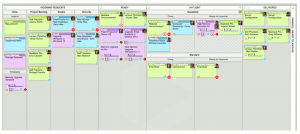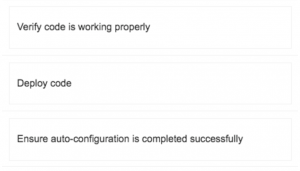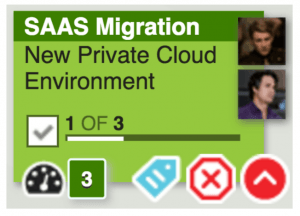With the advent of cloud-based technology, list-based project management tools have been gaining rapid popularity as a digital way track of to-dos.
They have definite advantages over paper to-do lists: You can access them on multiple devices, delegate tasks to others, and upload and attach files to tasks. This is all in addition to the logistical advantage of not having to keep track of a physical piece of paper.
But list-based tools have their limitations.
- They don’t provide context for a team’s work
- Complicated when multiple users or teams are involved
- They require lots of reading to fully come “up to speed”
- No visual cues to distinguish between high-priority and low-priority work
- No way to set limits based on capacity
- They don’t encourage collaboration across the team
List-based tools also fail to take advantage of the visual capabilities of our online devices. This is important, because humans process visual information thousands of times faster than text. Even with color coding, prioritization, etc., a list is still a collection of words, which needs to processed in context each time you view it.
Kanban is a method of workflow management that better aligns with our visual nature. Using cards on a digital board to represent work, teams practicing Kanban can visualize, manage, and optimize their workflow. Kanban encourages better collaboration, smarter decision-making, and faster delivery of value.
Read on to learn four reasons for choosing Kanban over list-based project management.
1. Kanban Boards are Visual
Kanban boards provide the visual information you need to minimize the chaos of your day. Based on a card’s color, location on a board, and other visual cues, you can tell the status of a piece of work. Some cloud-based Kanban tools even provide the ability to connect related card items, so you can see how a piece of work contributes to a higher-level initiative.
Let’s see this difference in practice: Imagine you are working on an IT operations team that’s deploying a new private cloud environment. In a list-based tool, a partial list of these tasks might look like this:
When you finish one of the items, it might disappear from the list. Then you’re left with #2 and #3, but out of how many? Did you finish the initiative? How many tasks are you actually responsible for? What is everyone else working on? Visualizing this information in a list format doesn’t provide context about your project.
Compare this to a Kanban card, with three task cards, one for each item. As you complete each task, you can move the card to its appropriate location and see the status of your overall project, but still stay focused on completing tasks, one at a time. You (and any stakeholders) can check the status of the new private cloud environment, see who’s working on it, and when it’s due.
2. Kanban Boards Improve Communication
One of the major advantages of Kanban over list-based apps is the ability to communicate information without relying on emails, meetings, or chasing people down for updates.
When you view a task on a to-do list, you can see the title of the task and perhaps the due date. Kanban cards communicate much more: assigned user, project type (indicated by card color), due date, status of any associated tasks, and icons to convey additional information.
With list-based apps, it’s difficult to understand the status of a piece of work. If your manager wants to know, for example, how much time you have left on a project, they have to interrupt via email, instant message, drive-by conversation, or status meeting, which disrupts the flow of your work.
Kanban boards help you passively communicate status without interrupting the flow of your work. As you move cards through your “swimlanes,” others can see and track progress. This allows you and your team to reduce context switching, keeping everyone focused on delivering value.
3. Kanban Boards Encourage a Prioritized Pull System
List-based apps allow you to prioritize your tasks, but they do not encourage you to limit how many “priorities” you have. Lists can be never-ending. If your to-do list has no limit, it’s difficult to say no to drive-by requests from coworkers, so the list keeps growing. Those one or two tasks that have the greatest value for the customer may fall through the cracks. This is called a “push” system — you do work as it is pushed onto your plate, without respect for your capacity or the goals of your team.
Kanban lets you work on as few as one card at a time until you have capacity to pull the next card; that’s why Kanban is referred to as a “pull” system. Teams can more effectively prioritize planned and unplanned work against what’s already in progress.
4. Kanban Boards Help You See Areas for Improvement
Another major differentiator between Kanban and list-based tools is that Kanban provides the ability to visually identify areas for improvement. In Kanban, this concept is known as continuous improvement — making incremental changes to your workflow to improve speed, efficiency, and quality.
Continuous improvement begins by first understanding your current state. By designing a Kanban board that accurately reflects your current process, you can see things like:
- Where work-in-progress stalls (bottleneck)
- Where work slows down due to external dependencies (blockers)
With this information, you can begin to make incremental changes to your workflow, then monitor, measure, and modify those changes as needed until you achieve continuous flow.
Mohammed Khalid leads the global solution engineers at LeanKit, where he equips his team with the tools to help organizations implement and sustain Lean-Agile transformations. He has worked in the Lean-Agile space for the past seven years, working closely with Fortune 100 organizations to help them apply and scale Agile-Lean project management solutions. Connect with Mohammed on LinkedIn.





